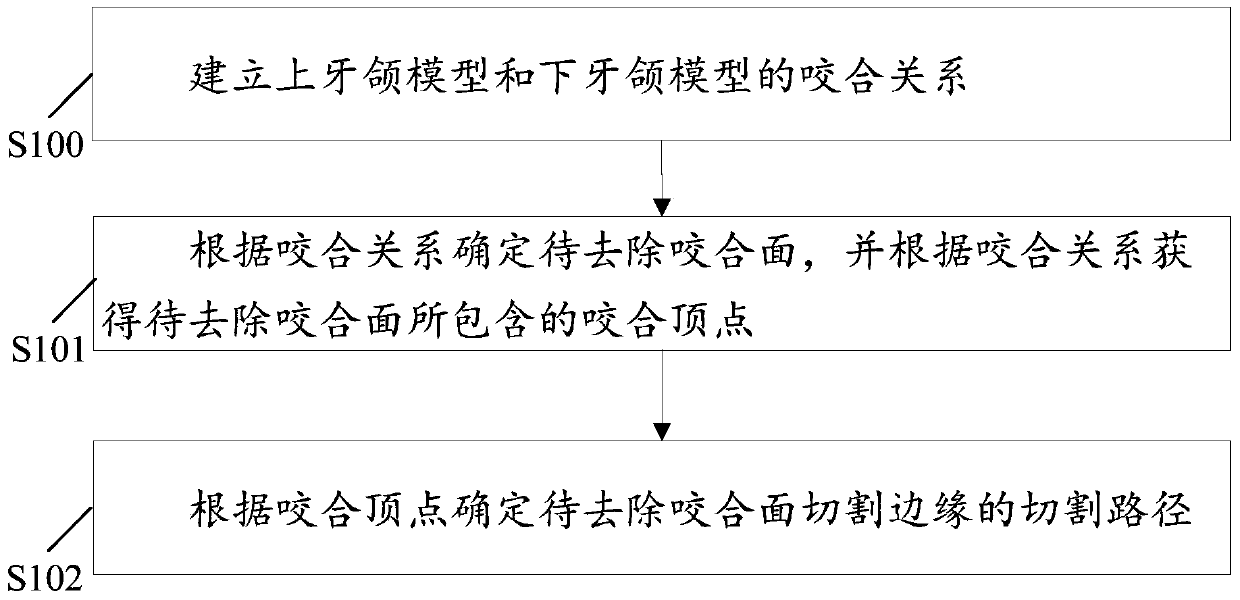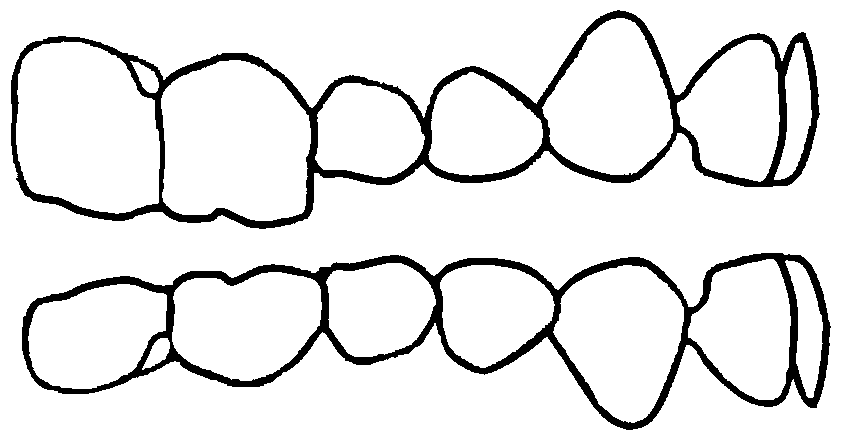Method for determining maxillofacial cutting path of appliance, cutting method and cutting device
A cutting path and appliance technology, applied in medical science, dentistry, dental drilling, etc., can solve problems such as easy missing teeth, large human factors, unfavorable stable relationship between upper and lower jaws, etc., and achieve precise and controllable cutting paths
- Summary
- Abstract
- Description
- Claims
- Application Information
AI Technical Summary
Problems solved by technology
Method used
Image
Examples
Embodiment 1
[0069] This embodiment provides a method for determining the maxillofacial cutting path of the appliance, the flow chart of which is as follows figure 1 As shown, it specifically includes the following steps.
[0070] S100: Establish an occlusal relationship between the upper jaw model and the lower jaw model.
[0071] S101: Determine the occlusal surface to be removed according to the occlusal relationship, and obtain occlusal vertices included in the occlusal surface to be removed according to the occlusal relationship.
[0072] S102: Determine the cutting path of the cutting edge of the occlusal surface to be removed according to the occlusal vertex.
[0073] The present invention determines the occlusal surface to be removed and the occlusal vertex contained in the occlusal surface to be removed by establishing an occlusal relationship, automatically performs the fitting of the cutting path according to the occlusal vertex, automatically identifies and determines the tra...
Embodiment 2
[0153] Based on Embodiment 1, this embodiment provides a method for cutting the maxillofacial appliance of an appliance. Based on the method of determining the cutting path on the dental model, the following example will be used to illustrate the cutting of the maxillofacial appliance of the appliance. The flow chart is as follows Figure 12 As shown, it specifically includes the following steps.
[0154] S1201: Determine the cutting path of the cutting edge of the occlusal surface to be removed in the appliance.
[0155] Step S1201 specifically determines the cutting path based on the mandibular model, which specifically includes the following steps:
[0156] 1) Establish the occlusal relationship between the upper jaw model and the lower jaw model;
[0157] 2) Determine the occlusal surface to be removed in the jaw model according to the occlusal relationship, and obtain the occlusal vertices contained in the occlusal surface to be removed according to the occlusal relation...
Embodiment 3
[0167] Based on Embodiment 1, this embodiment provides a method for cutting the maxillofacial appliance. Based on the method of determining the cutting path on the model of the appliance, the following example will be used to illustrate the cutting of the maxillofacial appliance. The flow chart is as follows Figure 13 As shown, it specifically includes the following steps.
[0168] S1301: Determine the cutting path of the cutting edge of the occlusal surface to be removed in the appliance.
[0169] Step S1301 specifically determines the cutting path based on the lower aligner model, which specifically includes the following steps:
[0170] 1) Establish the occlusal relationship between the upper jaw model and the lower jaw model;
[0171] 2) Obtain the appliance model according to the occlusal relationship between the upper jaw model and the lower jaw model;
[0172] 3) Determine the occlusal surface to be removed in the appliance model according to the occlusal relationshi...
PUM
 Login to view more
Login to view more Abstract
Description
Claims
Application Information
 Login to view more
Login to view more - R&D Engineer
- R&D Manager
- IP Professional
- Industry Leading Data Capabilities
- Powerful AI technology
- Patent DNA Extraction
Browse by: Latest US Patents, China's latest patents, Technical Efficacy Thesaurus, Application Domain, Technology Topic.
© 2024 PatSnap. All rights reserved.Legal|Privacy policy|Modern Slavery Act Transparency Statement|Sitemap



